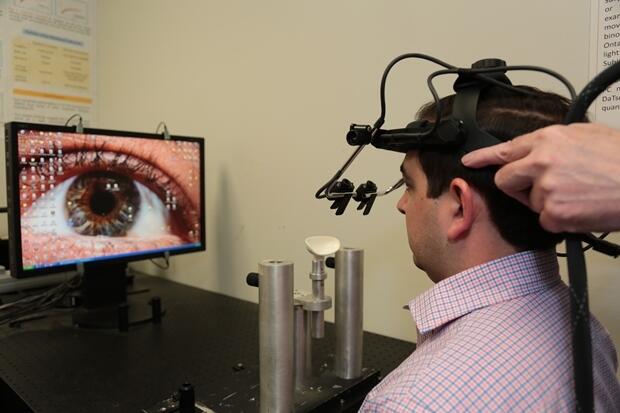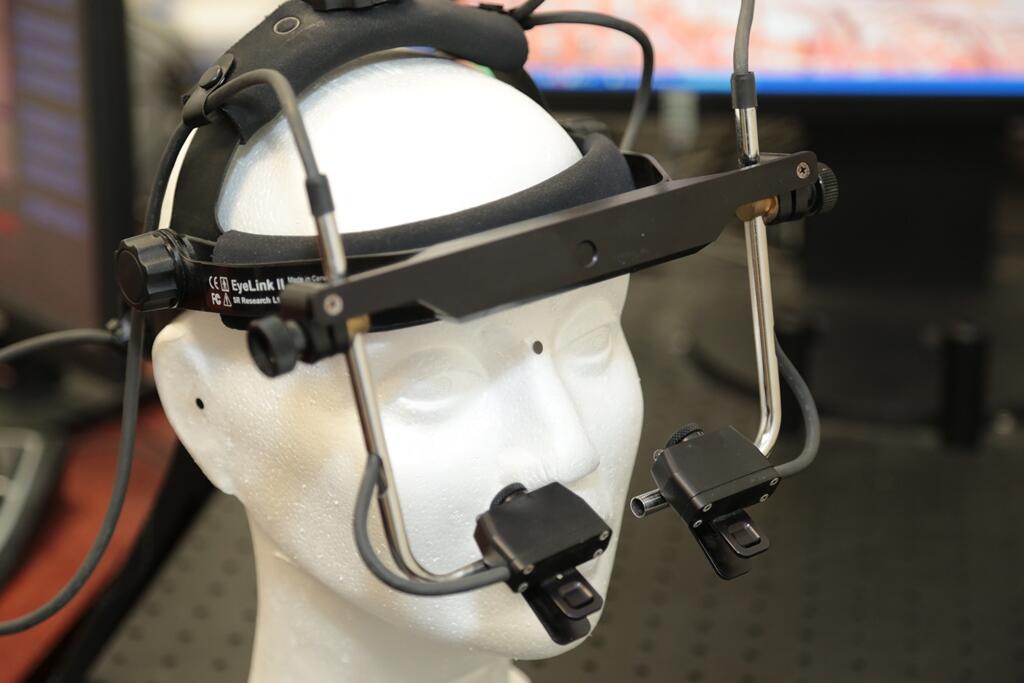
June 2, 2015
In the blink of an eye, VCU researchers detect early signs of movement disorders
Share this story
Even if you don’t know what Parkinson’s disease is, you can likely recall the image of Muhammad Ali’s trembling hands, halting speech and mask-like expression — common symptoms of a chronic and progressive movement disorder that affects as many as 1 million individuals in the United States alone.
Despite decades of intensive study, the causes of Parkinson’s remain unknown, and a cure is still elusive. What’s more, there is no standard diagnostic test for the disease.
Researchers at Virginia Commonwealth University are working hard to change this.
For the past 12 years, Mark Baron, M.D., professor of neurology and interim director of the VCU Parkinson’s and Movement Disorders Center, and Paul Wetzel, Ph.D., associate professor of biomedical engineering in the VCU School of Engineering, have collaborated on the development of an automated eye-tracking system that detects and analyzes eye movements as a means to accurately differentiate and diagnose more than 20 neurological diseases. Notably, these include essential tremor — often confused with Parkinson’s but eight times more common — and vascular Parkinsonism — one of several syndromes that mimic Parkinson’s.
Since 2008, Baron and Wetzel have been assisted by George Gitchel, a Ph.D. candidate in biomedical engineering at VCU and a health science research specialist at the Southeast/Richmond Veteran’s Affairs Parkinson’s Disease Research, Education and Clinical Center at the Hunter Holmes McGuire VA Medical Center, where Baron is deputy director. The Richmond PADRECC is one of six specialized centers created by the Department of Veterans Affairs in 2001 to serve the estimated 80,000 veterans affected by Parkinson’s.
Movement disorders: The basics
While scientists continue to look for the causes of Parkinson’s disease, they do know that it involves the malfunction and death of vital nerve cells in the brain called neurons. Some of these dying neurons produce dopamine, a chemical that sends messages to the part of the brain that controls movement and coordination. As these cells die, and less and less dopamine is produced in the brain, the symptoms of Parkinson’s progress, leaving a person unable to control movement normally.
Until the development of the VCU researchers’ eye-tracking system, the only way to confidently diagnose Parkinson’s was to confirm clinical findings with the drug levodopa, which replaces the dopamine that someone with Parkinson’s has lost. If the patient responds dramatically to levodopa, they likely have the disease; if they don’t respond dramatically, they probably don’t have it.
However, this seemingly straightforward test comes with several pitfalls: Patients may falsely perceive a benefit when there is none, other disorders may respond superficially to levodopa, and side effects can hinder patients’ ability to perceive a benefit. Thus, the test is often not as simple as establishing a response or no response; instead, it may be limited to the vague impression of a patient or family member, and a true diagnosis may require many visits.
If you take a population of movement disorder patients and follow them throughout their life, 65 percent will have their diagnosis changed at least once.
General neurologists and movement disorder specialists are 50 and 80 percent accurate, respectively. But, “if you take a population of movement disorder patients and follow them throughout their life, 65 percent will have their diagnosis changed at least once,” Gitchel said. Because no accurate test exists for any neurological disorder, the misdiagnosis rate is huge.
The case of normal pressure hydrocephalus — an excessive accumulation of fluid in the brain whose symptoms mimic PD — is particularly striking: Perhaps 80 percent of brain surgeries for this disorder fail because they’re misdiagnosed.
This is what the eye-tracking system promises to improve upon. The key to understanding this technology is the eye, which functions as the proverbial canary in the coal mine, registering early the brain’s incremental loss of dopamine-producing cells, or indeed anything else that affects the brain. Before any other part of the body, the eyes reveal, albeit invisibly, a loss of control that produces a variety of characteristic movements, including ocular tremors, harbingers of the motor and nonmotor symptoms that can take decades to manifest elsewhere.
How it all started
The effort to detect these characteristics began as an extension of the expertise Wetzel gained in the late 1980s and early 1990s while working to improve the ergonomics of Air Force cockpits. By tracking the eye movements of pilots, Wetzel could optimize the placement of the many cockpit instruments and controls; in collaboration with Baron, he applied the same technology to a different problem.
“It’s incredibly simple,” Gitchel said. Using infrared light, two head-mounted cameras follow the movement of a patient’s eyes as she attempts to fix her gaze on a screen-displayed object. While normal eye movements are highly regulated and follow well-defined patterns, neurological disorders alter eye movements in a fashion specific to the underlying condition.

In the early days after the creation of the Richmond PADRECC, Baron involved himself in too many projects. But once he realized the implications of his and Wetzel’s work on eye-movement tracking, he decided to devote more of his time and more of the center’s resources to this research and its clinical application. Most importantly, the hiring of Gitchel in 2008 allowed them to ramp up their effort.
Until then, Baron said, “We were dabbling all the way. Because [the project] became bigger and bigger, it was nice to finally have someone who was here full time. That’s where we were able to go from a snail’s pace to a blossoming to what it is today.”
Their research has consisted of two broad phases. Initially, for about two years, only patients with clinically confirmed disorders were tested, allowing the researchers to identify the patterns and parameters that describe particular diseases. Then, once they’d accumulated enough data, the team transitioned to seeing every new patient and comparing diagnoses made with and without the eye-tracking system.
Over the years, as they’ve refined the system, their accuracy has improved remarkably from 75-80 percent to nearly 100 percent today.
Before Gitchel’s arrival, Baron and his team had managed to test around 50 patients. Since then, they have looked at more than 3,000. These large numbers furnished data that made it “obvious that we could diagnose everything with incredible precision,” Baron said.
While the commercially available equipment is not particularly complicated, “the processing that goes on behind the scenes is,” Gitchel said. In addition to figuring out the signature patterns of each disorder, Wetzel and his collaborators have also written code that reads the cameras’ raw data, parses individual movements and calculates the parameters required for statistical analysis.
“Without a doubt,” Baron said, “this will be in everyone’s office at some point.”
Looking forward
With the hope of licensing their technology to a company, Baron and his collaborators agreed to partner with VCU Innovation Gateway in December 2012. Then, in August 2014, they filed for an international patent on the software they’ve developed. As Gitchel pointed out, “Anybody can buy the eye-tracking equipment off-the-shelf; it’s the research we’ve done over the years to figure what happens with an individual disorder, and the automated nature of our software, that’s what’s so valuable.”
In addition to being noninvasive and inexpensive, the researchers’ system is easy to implement, requiring minimal training time, minimal physician interaction and a mere five minutes to administer the test. What’s more, unlike the common electroencephalogram (EEG) or electromyography (EMG), the eye-tracking system produces data that do not need to be interpreted; when their current work is complete, the system will automatically generate a diagnosis.
So what needs to happen before this becomes widely used as a screening tool? Above all, the VCU researchers must overcome the skepticism of their professional peers, which Baron and Gitchel attribute to two main causes.
First, because the different eye rotations characteristic of neurological disorders are microscopic — about one quarter of a degree — and therefore cannot be detected without high-resolution cameras taking 500 photos per second, many doctors have never seen them and have difficulty accepting their existence.
Second, given the large number of publications by eminent eye researchers, many physicians wonder how the test for these disorders could be so simple, and why it wasn’t already figured out.
Gitchel meets this skepticism with a simple observation: “People have looked at eye movements for a hundred years. … And it’s always been, ‘Oh, look at this [strange eye movement]. Isn’t that interesting?’ But it was never [investigated] in a clinical setting. … That’s one of the beauties of what we do here. I’m the first door on this hallway; every single patient who comes in, I see them first. That’s why we have huge numbers and have been able to get such useful data. We’ve brought the research out of the lab and into a patient’s normal clinical visit. This is true translational research.”
We’ve brought the research out of the lab and into a patient’s normal clinical visit. This is true translational research.
Gitchel asserts that the use of this system brings an extraordinary degree of objectivity to a practice that is notoriously subjective and vague. Instead of the typical clinical exam, which combines family history with a patient’s performance on tasks such as stomping one’s foot and walking down a hall, their eye-tracking system “generates a massive amount of data very quickly” and creates “a way to purely quantify a disease,” Gitchel said.
Particularly remarkable is the system’s ability to diagnose drug-induced symptoms and combinations of disorders in the same patient, feats that are clinically difficult, and often impossible.
“The people who see [our system] in real time get it immediately,” Gitchel said. “I can sit down and explain all of it to you in 20 minutes. … [But] I can’t have a 20-minute conversation with every physician in the country. If someone big enough sees it and tells other people about it, then it’s going to start to get traction.”
Baron and Gitchel agreed that this someone would likely be a company that can shepherd their eye-tracking system through the arduous FDA-approval process.
Noting the huge profit potential of a device that could achieve ubiquity, Baron remarked, “We need a Shark Tank kind of person who says, ‘I’m going to make money,’ someone who’s going to make it happen.”
A neurosurgeon recently visited the Richmond PADRECC with a patient whose rare diagnosis had proved elusive. After Baron and Gitchel quickly and easily identified the condition using their system, the astounded physician said, “This is the greatest thing I’ve ever seen! Why doesn’t everyone have this?”
Feature image at top: George Gitchel, a Ph.D. candidate in biomedical engineering at VCU, models an automated eye-tracking system that detects and analyzes eye movements as a means to accurately differentiate and diagnose more than 20 neurological diseases.
Subscribe for free to the weekly VCU News email newsletter at http://newsletter.news.vcu.edu/ and receive a selection of stories, videos, photos, news clips and event listings in your inbox every Thursday. VCU students, faculty and staff automatically receive the newsletter. To learn more about research taking place at VCU, subscribe to its research blog, Across the Spectrum at http://www.spectrum.vcu.edu/
Subscribe to VCU News
Subscribe to VCU News at newsletter.vcu.edu and receive a selection of stories, videos, photos, news clips and event listings in your inbox.








